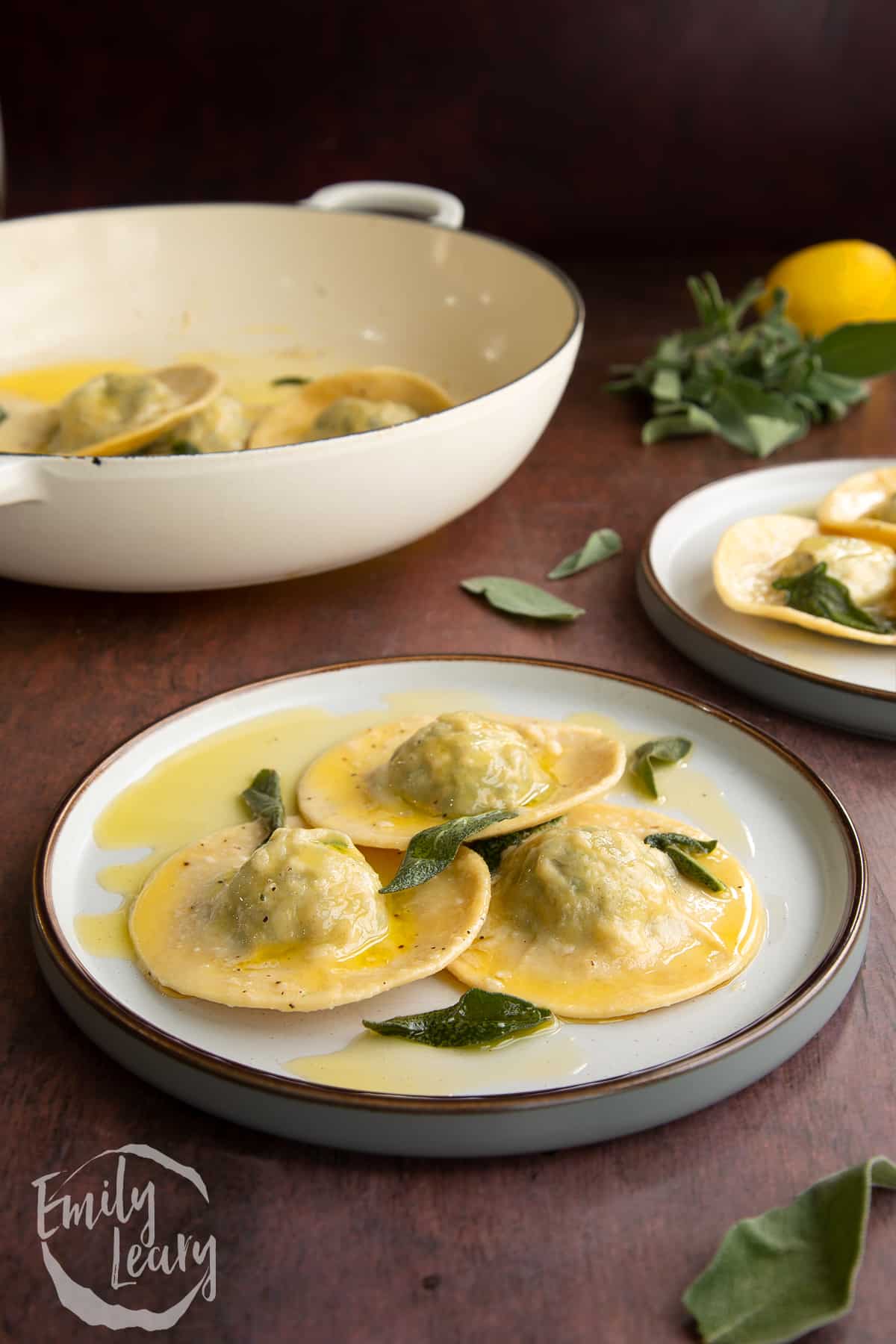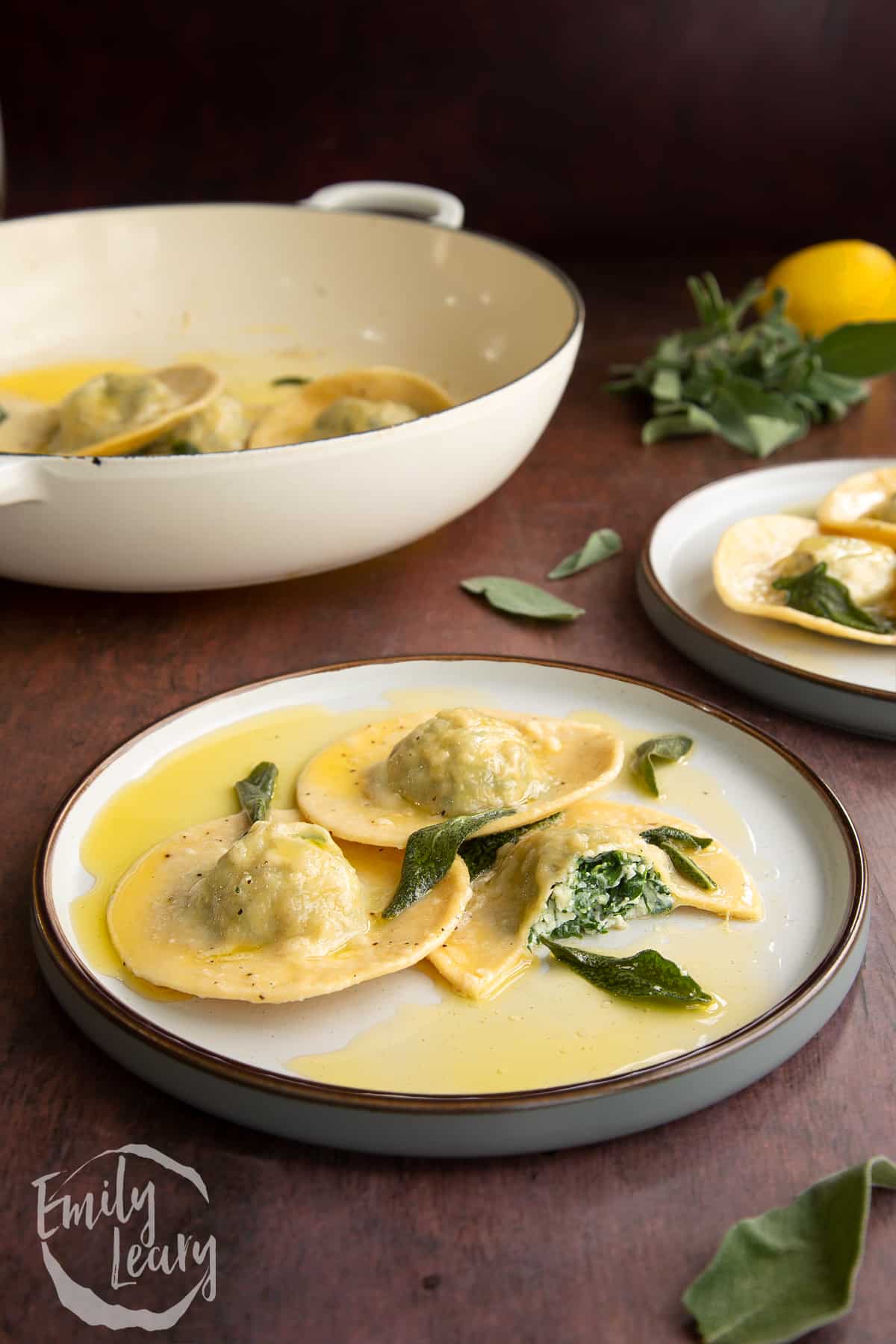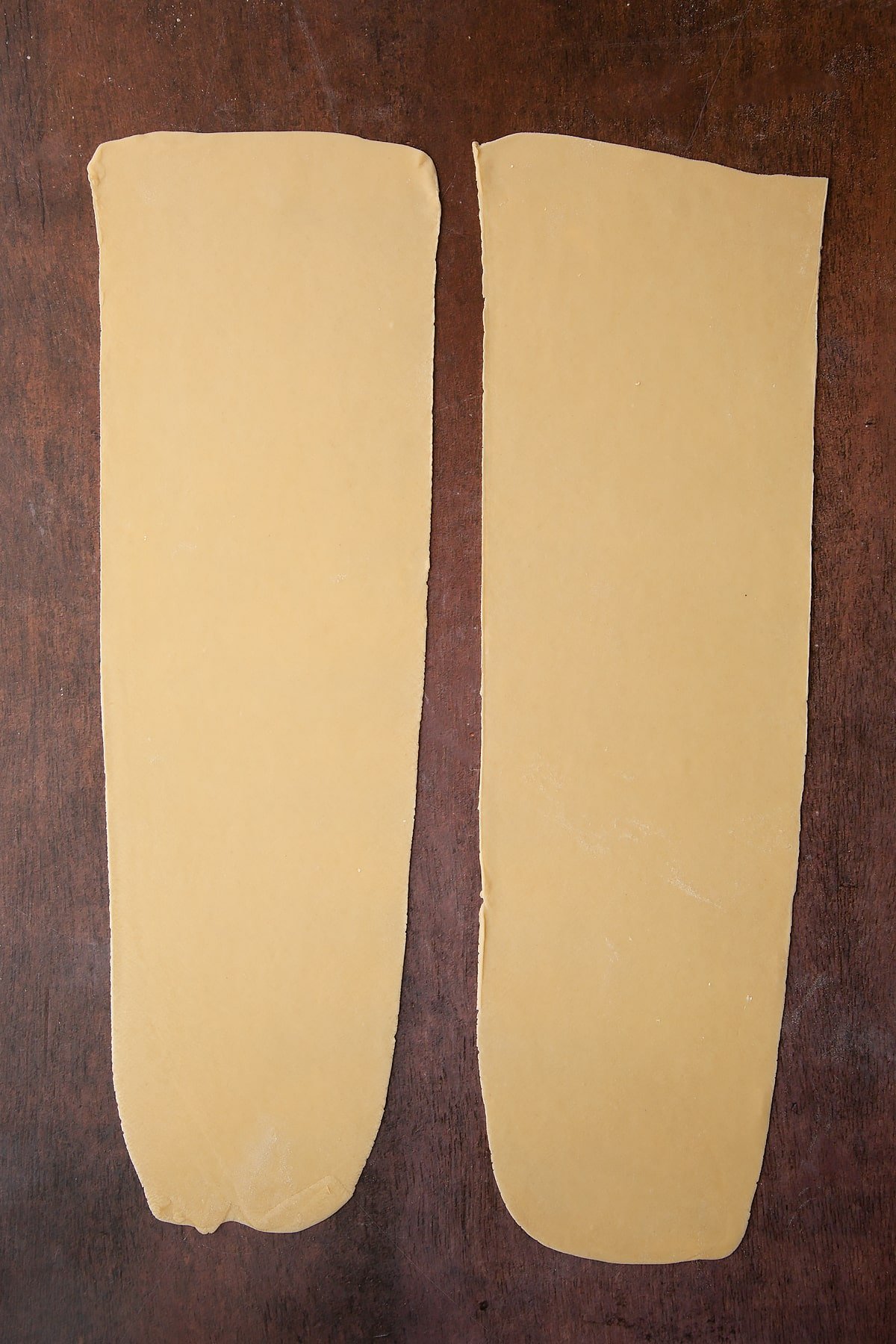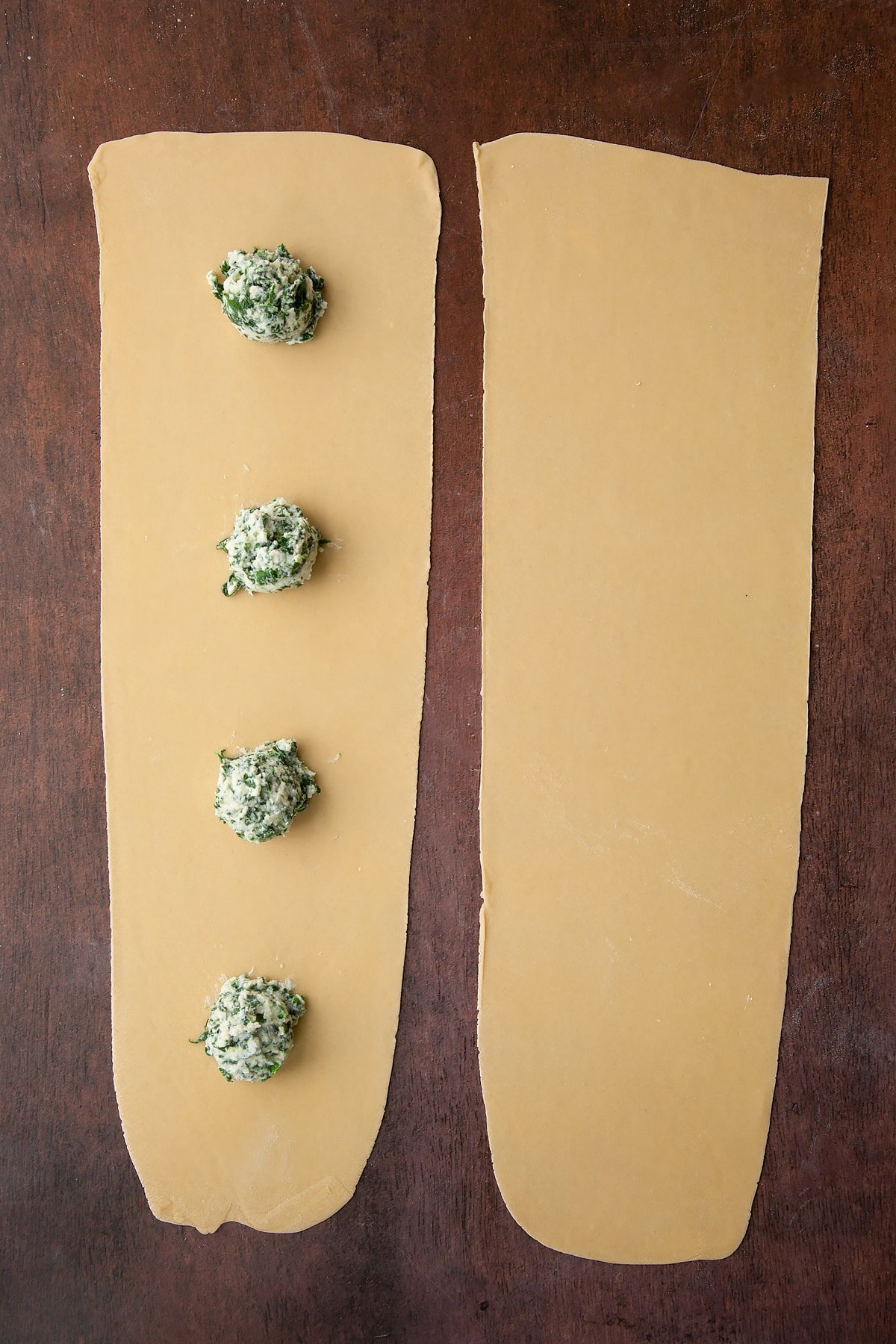This spinach and ricotta ravioli with sage butter is truly special. The ricotta and spinach, flavoured with Parmesan and nutmeg, then wrapped in tender from-scratch egg pasta, dressed in an irresistible sage and lemon butter sauce.

It's really easy to make this delicious fresh pasta. The dough is made using a food processor so it's super quick. All you do is pop the flour in the processor bowl and add the eggs while pulsing the blades until you have a sticky crumb that can be kneaded into a smooth dough.
The filling is made by quickly wilting spinach and then mixing with ricotta, grated Parmesan and a pinch of nutmeg. It's simple but utterly delicious and lets the natural flavours speak for themselves.

You'll then use a pasta machine to roll the pasta in to lovely thin pasta strips and fill it with the spinach and ricotta mixture, cutting out circular ravioli with a cookie cutter.

Finally, while the pasta boils, you'll make up an incredible sauce but frying fresh sage leaves in salted butter then bring it all together to produce this stunning ravioli dish.

Ready to try it? Here's the full recipe for my spinach and ricotta ravioli with sage butter.
Ingredients
For the spinach and ricotta filling
- ½ tbsp olive oil
- 200 g (7 oz) spinach washed and well dried
- 250 g (9 oz) ricotta cheese vegetarian if required, drained
- 100 g (1 cup) Parmesan or vegetarian hard cheese alternative finely grated
- pinch nutmeg
- pinch salt and black pepper
For the pasta dough
- 225 g (1½ cup) "00" pasta flour plus some to dust
- 2 medium eggs
- 2 medium egg yolks
- 2 tbsp semolina to dust the tray
For the sage butter
- 100 g (7 tbsp) salted butter
- 15 g (1 cup) fresh sage leaves
- 1 tbsp lemon juice
- pinch salt and black pepper
Instructions
Make the spinach and ricotta filling
Warm the oil in a pan.

Add the spinach.

Wilt for just 1-2 minutes.

Take off the heat and tip onto a board or plate to cool. Don’t skip this step or the heat will make the filling too loose to work with.
Put the ricotta, nutmeg, Parmesan and a pinch of salt and pepper in a bowl.

When the spinach is cold, press the excess liquid out, then chop roughly and add to the bowl.

Stir together with a fork.

Cover the bowl and put in the fridge to chill while you make the pasta.
Make the the pasta dough
Start the pasta by adding the flour to a food processor bowl.

Pulse the processor as you add the eggs one at a time until fully combined into a sticky, clumpy crumb.

If it seems dry and isn’t clumping, you can pulse in a tablespoon of egg white.
Turn out onto a clean surface and knead into a smooth dough.

Cover with cling film and leave to rest for 20-30 minutes to make it easier to work with.
Fill the ravioli
Divide the pasta dough in half, working one piece at a time whilst keeping the other wrapped to prevent it from drying out.
Shape the piece into a rectangle and set the pasta machine to its widest setting. Pass the pasta through the machine, then fold up and pass through again at 90 degrees from the folds. Repeat until you have a smooth sheet without tears, splits or dry patches.

You can now reduce the number on your machine by one and pass the pasta through again twice. Keep working down the numbers, passing the pasta through twice each time and dusting with a tiny bit of flavour if it sticks until you are down to at least the penultimate setting (e.g. if your machine runs from 7 down to 1, then don't stop sooner than setting 2).
Dust the underside of the strip very lightly with flour so that it doesn't stick and lay it out flat. Cut it in half so that you have two shorter strips, side by side.

Spoon four tablespoons of filling along the length of the strip, well spaced apart.

You now need to place pasta over the ricotta filling. You could do this my lifting the whole sheet, but I find it easiest to cut the sheets into fours.

This means that you can I can place a square on top of each round of ricotta.

Press all the way round firmly, making sure to press out any air out before sealing.

Cut out each of the ravioli rounds using a large, plain-edged 9cm (3.5 inch) cookie cutter. A glass tumbler or knife will work too.

Pull away the pasta offcuts and cover them to rest use later. Check your ravioli are sealed all around and press around the edges further if needed to seal.

Sprinkle semolina generously on a tray and arrange the ravioli as you work, sprinkling more semolina on top too so that they don’t stick together.
Repeat with the remaining pasta dough and filling. Now gather up the rested offcuts and repeat the kneading and rolling process to produce more pasta you can fill with the remaining filling.
You should get about 24 in total.
If you have leftover pasta dough after you've used up all your filling, you can gather it up, repeat the kneading process, put back through the machine and make some tagliatelle, which will keep in the fridge for 1-2 days.

Leave your ravioli to firm a little while you make the sauce. If you’re not ready to cook them straight away, cover the tray loosely with clingfilm and place in the fridge for up to 48 hours.
Cook the pasta and sauce
Bring a large pan of salted water to the boil.
Put the salted butter in a large frying pan over a medium heat.

Meanwhile, lower the ravioli into the boiling water. They will cook in just 4 minutes.
Heat gently until all the butter is melted.

Add the sage leaves.

Fry until they are sizzling, then add the lemon juice.

Drain the pasta and add to the pan with the butter, basting to cover.

Serve the pasta to plates, spooning some of the sage butter on top and serve immediately.

Enjoy!

Print this recipe for spinach and ricotta ravioli with sage butter
Spinach and Ricotta Ravioli with Sage Butter Recipe
Ingredients
For the spinach and ricotta filling
- ½ tbsp olive oil
- 200 g (7 oz) spinach washed and well dried
- 250 g (9 oz) ricotta cheese vegetarian if required, drained
- 100 g (1 cup) Parmesan or vegetarian hard cheese alternative finely grated
- pinch nutmeg
- pinch salt and black pepper
For the pasta dough
- 225 g (1½ cup) "00" pasta flour plus some to dust
- 2 medium eggs
- 2 medium egg yolks
- 2 tbsp semolina to dust the tray
For the sage butter
- 100 g (7 tbsp) salted butter
- 15 g (1 cup) fresh sage leaves
- 1 tbsp lemon juice
- pinch salt and black pepper
Instructions
Make the spinach and ricotta filling
- Warm the oil in a pan and add the spinach, wilting for just 1-2 minutes.
- Take off the heat and tip onto a board or plate to cool. Don’t skip this step or the heat will make the filling too loose to work with.
- When the spinach is cold, press the excess liquid out, then chop roughly and transfer to a bowl.
- Put the ricotta, nutmeg, Parmesan and a pinch of salt and pepper in a bowl.
- Add the chopped spinach and stir together with a fork.
- Cover the bowl and put in the fridge to chill while you make the pasta.
Make the the pasta dough
- Start the pasta by adding the flour to a food processor bowl and pulsing the processor as you add the eggs one at a time until fully combined into a sticky, clumpy crumb.
- If it seems dry and isn’t clumping, you can pulse in a tablespoon of egg white.
- Turn out onto a clean surface and knead into a smooth dough.
- Cover with cling film and leave to rest for 20-30 minutes to make it easier to work with.
Fill the ravioli
- Divide the pasta dough in half, working one piece at a time whilst keeping the other wrapped to prevent it from drying out.
- Shape the piece into a rectangle and set the pasta machine to its widest setting. Pass the pasta through the machine, then fold up and pass through again at 90 degrees from the folds. Repeat until you have a smooth sheet without tears, splits or dry patches.
- You can now reduce the number on your machine by one and pass the pasta through again twice. Keep working down the numbers, passing the pasta through twice each time and dusting with a tiny bit of flavour if it sticks until you are down to at least the penultimate setting (e.g. if your machine runs from 7 down to 1, then don't stop sooner than setting 2).
- Dust the underside of the strip very lightly with flour so that it doesn't stick and lay it out flat. Cut it in half so that you have two shorter strips, side by side.
- Spoon four tablespoons of filling along the length of the strip, well spaced apart.
- You now need to place pasta over the ricotta filling. You could do this my lifting the whole sheet, but I find it easiest to cut the sheets into fours so that I can place a square on top of each round of ricotta. Press all the way round firmly, making sure to press out any air out before sealing.
- Cut out each of the ravioli rounds using a large, plain-edged 9cm (3½ inch) cookie cutter. A glass tumbler or knife will work too.
- Pull away the pasta offcuts and cover them to rest use later. Check your ravioli are sealed all around and press around the edges further if needed to seal.
- Sprinkle semolina generously on a tray and arrange the ravioli as you work, sprinkling more semolina on top too so that they don’t stick together
- Repeat with the remaining pasta dough and filling. Now gather up the rested offcuts and repeat the kneading and rolling process to produce more pasta you can fill with the remaining filling. You should get 16 in total.
- Leave them to firm a little while you make the sauce. If you’re not ready to cook them straight away, cover the tray loosely with clingfilm and place in the fridge for up to 48 hours.
- If you have leftover pasta dough after you've used up all your filling, you can gather it up, repeat the kneading process, put back through the machine and make some tagliatelle, which will keep in the fridge for 1-2 days.
Cook the pasta and sauce
- Bring a large pan of salted water to the boil.
- Put the salted butter in a large frying pan over a medium heat.
- Meanwhile, lower the ravioli into the boiling water. They will cook in just 4 minutes.
- Heat the butter gently until melted, then add the sage leaves and fry until they are sizzling, then add the lemon juice.
- Drain the pasta and add to the pan with the butter, basting to cover.
- Serve the pasta to plates, spooning some of the sage butter on top and serve immediately.
Video
Notes
Nutrition
Pin this recipe for spinach and ricotta ravioli with sage butter






More pasta recipes to try
I've got lots more amazing pasta recipes. For starters, try these fantastic family recipes.
Have you got my book?

'This is a great kids cookery book. Emily is a star' - Simon Rimmer
'The book I'd like to force into any mother's kitchen' - Prue Leith
"A fab book with a plan." - Jane Devonshire, 2016 Masterchef UK winner
'Emily has managed to combine her mummy knowledge and passion for food to make a truly helpful and brilliant cookbook' - Priya Tew, RD, BSc (Hons), Msc
Get Your Kids to Eat Anything is an achievable 'how to' for parents in the battle to overcome picky eating and 'make new the norm'. Emily Leary's unique 5-phase programme looks at the issue of 'fussy eating' in a holistic way that links imagination with food, and which situates parents alongside - not in opposition to - their children.







Sydney says
A local restaurant makes a spinach and sage ravioli, so I was excited to find this recipe to see how it compares. My husband and I were not disappointed with the result. It tastes SO MUCH like the restaurant and costs less too. Thank you for sharing!
Emily Leary says
I'm so pleased!!
Inside the Wendy House says
One day i must try to make my own pasta. Yours looks fabulous Emily! x
TheBoyandMe says
Can you make this for me please? I'm so rubbish at making pasta, it just ends up grey and floury.
Rachel says
This is a great post. It isn't always easy to make food look good but these are fab photos. It looks absolutely delicious. I have only just started making my own pasta but it is so worth it. However, at the moment, I have to use it within the hour for it still to look good. Is there a way of keeping it a little longer so that I can be a little tidier before I serve food to friends? :-)
Emily Leary says
Thank you! :)
Hehe, I have that problem too - pasta needs to be cooked and the counter is covered in pasta bits and caked in flour!
I find if you dust the completed pasta liberally with the fine polenta in a bowl (make sure there's polenta between each piece) and then cover the bowl with clingfilm, it should be fine for a couple of hours, which gives you time to wipe round, make whatever accompaniments you have in mind etc.
When you come to boil the pasta, just shake off the excess polenta and the rest will just wash into the water and dissolve without making the pasta stodgy or overly dry like a wheat flour would.
Steph (@imcountingufoz) says
Oh my gosh! This looked absolutely delicious.
Emily Leary says
Thank you , m'dear. Don't forget to link your awesome video up with #recipeoftheweek x